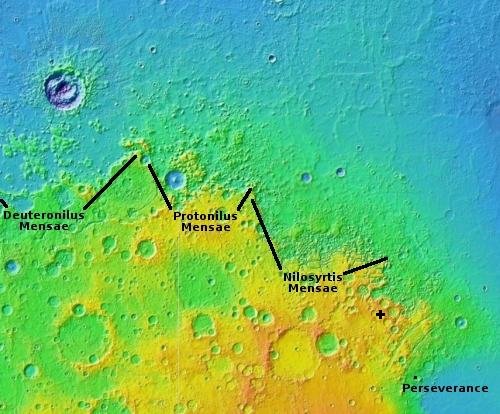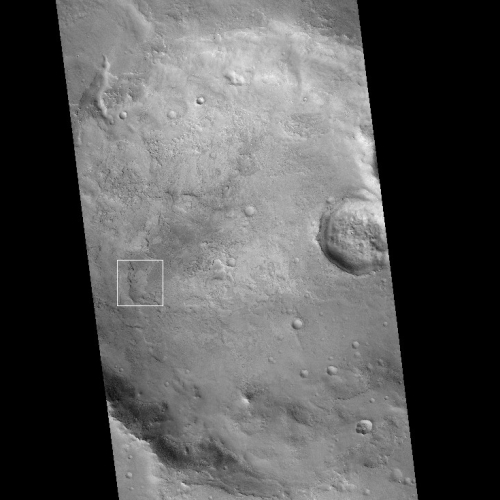A dry bedrock Martian crater floor?
Cool image time! The photo to the right, cropped and reduced to post here, was taken on June 21, 2021 by the high resolution camera on Mars Reconnaissance Orbiter (MRO). The location is a very eroded crater at about 26 degrees north latitude. The image shows the crater’s crater floor, with a variety of bedrock-type features, sharp ridges, abrupt scarps, and flat smooth plateaus, with a hint of lobate glacial flows in the image’s southeast quadrant.
At 26 north latitude, it is unlikely that anything here is icy, unless it is very well protected by debris. Most of these features are almost certainly bedrock, though their formation could very well have been shaped by ice in past eons when this location was more amenable to water ice.
The wider MRO context camera image of the entire crater, plus the overview map, give a larger picture, and raise some interesting questions.

The white box in the context camera image, cropped and reduced to post here, shows the area covered by the cool image above. As you can see, this crater is very eroded, and in fact looks extremely old.
The black cross in the overview map marks the location of this crater. Sitting just inside the southern cratered highlands and very close to the transition zone and the 2,000 mile-long strip of chaos terrain from 30 to 47 degrees north latitude that I call glacier country on Mars (marked by the mensae regions dubbed Deuteronilus, Protonilus, and Nilosyrtis Mensae), the crater’s very dry look raises a mystery. In these mensae regions practically any image taken by MRO shows soft and flowing glacial-like features. This terrain is filled with ice.
Yet, in this crater, only a few degrees to the south, the crater floor appears entirely dry and hard. Can the transition from glacial bands above 30 degrees latitude to the dry equatorial regions in lower latitudes be this sharp? And if so, why?
This was a question I asked a scientist a few years ago when their research had first identified those mid-latitude bands of glaciers from 30 to 60 degrees latitudes. Why are the bands so specific? Shouldn’t they peter out more gradually? The scientist had no answer.
It could very well be that these glacial bands are the region where the near-surface ice on Mars is petering out. Above these bands the ice is in vast sheets, either in thick layers underground, very near or on the surface. Closer to the equator there is no ice close to the surface, at all. In between however the ice only partly covers the ground, and is exhibited in glacial flows.
All theories, all unproven. We need to go to actually find out.
On Christmas Eve 1968 three Americans became the first humans to visit another world. What they did to celebrate was unexpected and profound, and will be remembered throughout all human history. Genesis: the Story of Apollo 8, Robert Zimmerman's classic history of humanity's first journey to another world, tells that story, and it is now available as both an ebook and an audiobook, both with a foreword by Valerie Anders and a new introduction by Robert Zimmerman.
The print edition can be purchased at Amazon or from any other book seller. If you want an autographed copy the price is $60 for the hardback and $45 for the paperback, plus $8 shipping for each. Go here for purchasing details. The ebook is available everywhere for $5.99 (before discount) at amazon, or direct from my ebook publisher, ebookit. If you buy it from ebookit you don't support the big tech companies and the author gets a bigger cut much sooner.
The audiobook is also available at all these vendors, and is also free with a 30-day trial membership to Audible.
"Not simply about one mission, [Genesis] is also the history of America's quest for the moon... Zimmerman has done a masterful job of tying disparate events together into a solid account of one of America's greatest human triumphs."--San Antonio Express-News
Cool image time! The photo to the right, cropped and reduced to post here, was taken on June 21, 2021 by the high resolution camera on Mars Reconnaissance Orbiter (MRO). The location is a very eroded crater at about 26 degrees north latitude. The image shows the crater’s crater floor, with a variety of bedrock-type features, sharp ridges, abrupt scarps, and flat smooth plateaus, with a hint of lobate glacial flows in the image’s southeast quadrant.
At 26 north latitude, it is unlikely that anything here is icy, unless it is very well protected by debris. Most of these features are almost certainly bedrock, though their formation could very well have been shaped by ice in past eons when this location was more amenable to water ice.
The wider MRO context camera image of the entire crater, plus the overview map, give a larger picture, and raise some interesting questions.

The white box in the context camera image, cropped and reduced to post here, shows the area covered by the cool image above. As you can see, this crater is very eroded, and in fact looks extremely old.
The black cross in the overview map marks the location of this crater. Sitting just inside the southern cratered highlands and very close to the transition zone and the 2,000 mile-long strip of chaos terrain from 30 to 47 degrees north latitude that I call glacier country on Mars (marked by the mensae regions dubbed Deuteronilus, Protonilus, and Nilosyrtis Mensae), the crater’s very dry look raises a mystery. In these mensae regions practically any image taken by MRO shows soft and flowing glacial-like features. This terrain is filled with ice.
Yet, in this crater, only a few degrees to the south, the crater floor appears entirely dry and hard. Can the transition from glacial bands above 30 degrees latitude to the dry equatorial regions in lower latitudes be this sharp? And if so, why?
This was a question I asked a scientist a few years ago when their research had first identified those mid-latitude bands of glaciers from 30 to 60 degrees latitudes. Why are the bands so specific? Shouldn’t they peter out more gradually? The scientist had no answer.
It could very well be that these glacial bands are the region where the near-surface ice on Mars is petering out. Above these bands the ice is in vast sheets, either in thick layers underground, very near or on the surface. Closer to the equator there is no ice close to the surface, at all. In between however the ice only partly covers the ground, and is exhibited in glacial flows.
All theories, all unproven. We need to go to actually find out.
On Christmas Eve 1968 three Americans became the first humans to visit another world. What they did to celebrate was unexpected and profound, and will be remembered throughout all human history. Genesis: the Story of Apollo 8, Robert Zimmerman's classic history of humanity's first journey to another world, tells that story, and it is now available as both an ebook and an audiobook, both with a foreword by Valerie Anders and a new introduction by Robert Zimmerman.
The print edition can be purchased at Amazon or from any other book seller. If you want an autographed copy the price is $60 for the hardback and $45 for the paperback, plus $8 shipping for each. Go here for purchasing details. The ebook is available everywhere for $5.99 (before discount) at amazon, or direct from my ebook publisher, ebookit. If you buy it from ebookit you don't support the big tech companies and the author gets a bigger cut much sooner.
The audiobook is also available at all these vendors, and is also free with a 30-day trial membership to Audible.
"Not simply about one mission, [Genesis] is also the history of America's quest for the moon... Zimmerman has done a masterful job of tying disparate events together into a solid account of one of America's greatest human triumphs."--San Antonio Express-News




That is Art.
Thank you.
pawn: Existence is art, when enjoyed fully and honestly.